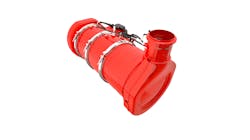Exhaust and emission aftertreatment systems explained
In response to an increasing push for clean diesel emissions, medium and heavy duty diesel-powered trucks have adopted complex exhaust or emission aftertreatment systems. These systems treat post-combustion gases after they leave the engine, reducing environmental impact without sacrificing power or performance.
Although aftertreatment systems have been used for years now, many fleets continue to struggle with maintaining and repairing these systems. A properly maintained aftertreatment system ensures that emissions are kept at or below government regulation requirements. To maximize uptime and minimize costly repairs, it is helpful for fleets to understand how aftertreatment systems work so they can better understand how to maintain them.
Primary components
The primary components of a vehicle’s aftertreatment system are the diesel particulate filter system (DPF), which reduces particulates, and the selective catalytic reduction system (SCR), which reduces nitrogen oxide (NOx).
The DPF system consists of the following:
- Diesel Oxidation Catalyst (DOC) – The DOC reduces particulate matter and oxidizes carbon monoxide and hydrocarbons.
- DPF – This filter is designed to remove more than 90 percent of particulates out of the exhaust, according to Raymond Parrish, Service Engineer at Cummins.
Cummins designs, distributes and services diesel and natural gas engines and related technologies, including fuel system, controls, air handling, filtration, emission solutions and electrical power generation systems.
The SCR system consists of these components:
- Diesel Exhaust Fluid (DEF) – A solution made of urea and deionized water. DEF is introduced into the exhaust stream to reduce NOx emissions.
- DEF pump – A part of the DEF delivery system that vacuums DEF from the tank, through the pump, filters the DEF and primes and maintains pressure between the DEF pump and doser.
- DEF doser – The doser injects DEF into the exhaust system.
- Decomposition chamber – This assists in mixing the exhaust stream with DEF prior to the SCR.
- SCR – This is the catalyst for the chemical reaction that transforms the combination of the exhaust stream and decomposed DEF to meet regulations for NOx emissions.
“The DOC and DPF work together at the front end of the system to reduce carbon monoxide and hydrocarbons, but more importantly, capture soot and ash in the exhaust system to reduce the risk of those particles reaching the atmosphere,” Parrish explains.
“From there, the exhaust moves through a mixing chamber that introduces DEF … needed for the chemical reaction to reduce NOx in the SCR. The resulting ‘exhaust’ that gets reintroduced into the atmosphere is comprised of harmless nitrogen gas and water vapor.”
In addition to the primary components of the aftertreatment system, there are also sensors. A differential pressure sensor estimates captured particles in the DPF. Exhaust gas temperature sensors monitor the system temperatures. NOx sensors measure the NOx conversion. PM (particulate matter) sensors, also known as soot sensors, measure particulates in the exhaust (mainly ash and soot). All of these sensors indicate when the aftertreatment system needs repair or maintenance.
Aftertreatment system maintenance
A DPF collects diesel particulates in the diesel engine’s exhaust. Over time, this filter can become clogged. To ensure that the DPF continues to work effectively, it should be serviced regularly. DPF service intervals are specified by engine manufacturers, so be sure to consult your service manual to determine how often the DPFs in your fleet should be cleaned or replaced.
“Cummins recommends replacement with a reconditioned DPF instead of air cleaning,” says Parrish. “A reconditioned DPF ensures performance results and effective service events. The DPF should be serviced when dash lamps notify the operators, or when your service manual specifies.”
Scott Barraclough, technology product manager for Mack Trucks, adds, “Mack recommends cleaning the DPF every 400,000 miles or 10,000 hours. Many Mack dealers can now clean DPFs in-house. They can also exchange your soiled DPF for a cleaned one.”
Mack Trucks is a manufacturer of heavy duty Class 8 trucks, engines and transmissions.
It is important that drivers pay attention to aftertreatment system warning indicators and symbols. These lamps notify the driver to take action to ensure the health of the aftertreatment system. If ignored, it can result in damage to the system and derate conditions, including torque and speed reductions, Cummins’ Parrish says.
“Ignoring maintenance can result in reduced performance and possible permanent damage to emission control components,” Barraclough says. A damaged DPF can cause expensive repairs that could be avoided with regular system maintenance.
Mack Trucks has no prescribed replacement cycle for a DPF, as long as it is cleaned regularly, Barraclough notes.
“Provided the DPF is not cracked or damaged, it should last the life of the vehicle with recommended maintenance and cleaning,” Barraclough says
Automatic and parked regeneration
Automatic and parked regenerations help clean trapped soot, oil and ash caught in the DPF to help ensure that the filter remains in good working order. These regenerations, or regens, clean the filter in between the manufacturer’s maintenance guidelines.
Automatic regeneration is commanded by the engine control module at a set interval, without any action from the operator. “The operator may not even be aware automatic regens are happening,” Mack Trucks’ Barraclough says.
“[These regens usually] have a speed limit to prevent non-requested regeneration while parked. Automatic regeneration will normally occur during freeway operations, when the exhaust temperatures are most ideal,” Cummin’s Parrish adds.
During active DPF regeneration, the exhaust temperature elevates to around 500 degrees C. These temperatures allow for the oxidation of soot, which in turn cleans the filter.
Unlike automatic regeneration, which is commanded by the control module, manual regeneration, or parked regeneration, is commanded by the operator. Manual regens are usually completed when automatic generation isn’t possible.
“Parked regenerations are commonly done in vehicles that do not have enough highway operation or [that] experience lower exhaust temperatures,” Parrish says “This is also performed after service events to ensure system health.”
When performing a manual regeneration, it is important to ensure the vehicle is in a safe location because radiating temperatures can be significant and last up to one hour, says Parrish.
Conclusion
While aftertreatment systems are often overlooked and neglected in terms of maintenance, these systems are important to the performance of diesel trucks. Because an unclean DPF filter can clog and damage other emission components, ignoring recommended cleaning or replacement intervals can cause engine performance issues, reduced efficiency, damage to emission control components and ultimately, unplanned downtime and costly repairs. Consequently, it is important for fleets and service personnel to understand the key benefits of maintaining their aftermarket treatment systems, and how those systems contribute to the trucks’ overall performance.
If you'd like more information and articles like this in your inbox, subscribe to the Fleet Maintenance Today newsletter.
About the Author
Stefanie Von Rueden
Assistant Editor - Vehicle Repair Group
Stefanie Von Rueden is assistant editor for the Vehicle Repair Group.
Von Rueden’s background includes professional writing and publishing. Previously, she worked in the Continuing Education department at UW-Whitewater. She has covered the vehicle maintenance and automotive aftermarket since 2016.

